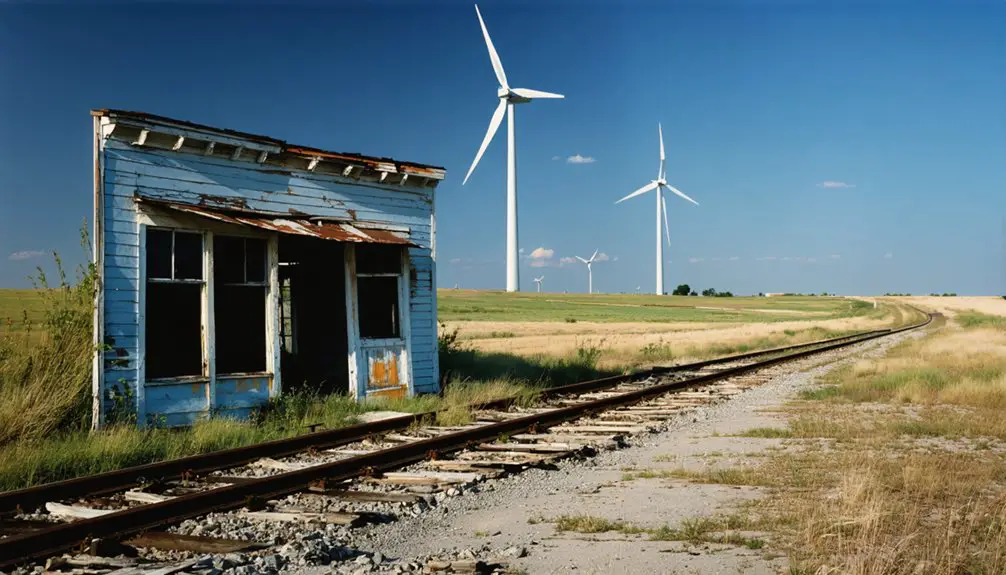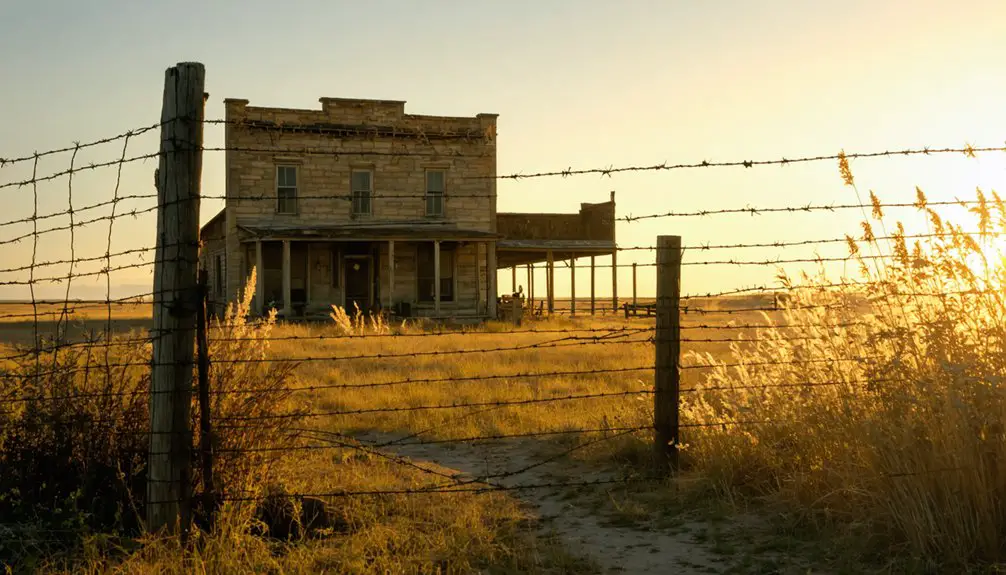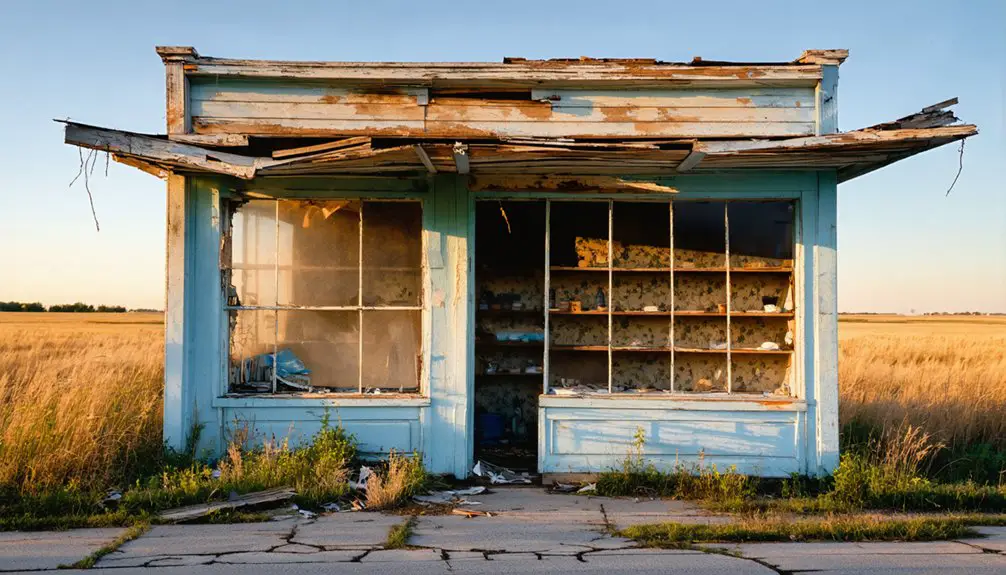You’ll find Mertilla’s ghost town story in Meade County, Kansas, where Sam High’s grocery store marked its start in 1885. The frontier town grew to include a post office, hotel, and multiple businesses around Wild Horse flats. Despite early promise, Mertilla’s fortunes turned after losing the county seat to Meade Center in the mid-1880s. By 1893, the legislature officially vacated the site, and today, this once-hopeful prairie settlement holds countless untold tales beneath Kansas soil.
Key Takeaways
- Mertilla was established in 1885 in Meade County, Kansas, beginning with Sam High’s grocery store before becoming a ghost town by 1893.
- The town’s decline started in 1887 when residents began dismantling buildings after losing the county seat election to Meade Center.
- Located on Wild Horse flats, Mertilla featured a post office, hotel, blacksmith shop, and newspaper during its brief existence.
- The legislature officially vacated the townsite in 1893 due to population loss, natural disasters, and loss of railroad connections.
- No physical structures remain of Mertilla today, with most buildings having been relocated or repurposed throughout Meade County.
The Pioneer Days: First Building and Founding
As pioneers pushed westward into Kansas during the fall of 1885, the small settlement of Mertilla took root in Meade County, strategically positioned near Wild Horse Lake.
You’ll find the pioneer spirit embodied in the town’s humble beginnings, where four oxen hauled the first one-room building that would become Sam High’s grocery store.
The founding individuals who shaped Mertilla’s early days included “Red” Jim High, Joseph E. Sherrill, and Henry C. Shuey, who served as key figures in the town’s development.
You can imagine the determination it took to establish this frontier outpost, where both sod and wood-frame buildings soon dotted the landscape. Settlers relied on goods from Dodge City to stock their growing businesses and homes.
The Kansas Town and Land Company managed the 50-acre townsite, marking the beginning of what they hoped would become a thriving community. The area later became home to Jasper Post Office in 1888, providing vital communication services to residents.
Early Businesses and Commerce
While Sam High’s grocery store marked Mertilla’s first commercial venture in 1885, the town’s business district soon expanded to include a diverse array of establishments.
You’d find Dr. Ostrander’s drug store, which he’d relocated from Carthage, alongside two other retail shops serving the growing community. The town’s commerce centered around its strategic crossroads location near Wild Horse Lake, where you could stop at the local hotel or visit the bustling blacksmith shop for repairs.
H.L. Bishop’s “Mertilla Times” kept residents informed of local business happenings, while the post office facilitated trade communications. Like many Kansas towns, Mertilla faced challenges from harsh weather conditions that impacted local commerce. The livery barn provided essential transportation services, making Mertilla a genuine hub for travelers and farmers alike. The town’s modest infrastructure reflected its status as a typical country crossroads settlement.
These businesses reflected the town’s early promise as a commercial center.
Life in Late 1800s Mertilla
During the late 1800s, life in Mertilla centered around its bustling crossroads location on the Wild Horse flats.
You’d find yourself among a diverse mix of store owners, blacksmiths, and newspaper staff, all working to support frontier living. Community gatherings took place at the local hotel and shops, where you’d catch up on the latest news from The Mertilla Times. Like many nearby settlements that saw their population decline sharply, Mertilla struggled to maintain its vitality.
Locals gathered at Mertilla’s shops and hotels, sharing stories while merchants and craftsmen kept the frontier town running.
Daily life revolved around agricultural practices and livestock management, with oxen teams powering much of the heavy work. Like many farming ghost towns in the Great Plains, Mertilla’s residents faced constant challenges from droughts and economic hardships.
You’d have relied on freight deliveries from Dodge City for supplies, while nearby Wild Horse Lake offered opportunities for recreation.
Though the town thrived briefly at the intersection of major roads, you’d have witnessed its decline by 1888 when the railroad chose alternate routes, leading to Mertilla’s eventual abandonment.
Town Layout and Key Structures
The layout of Mertilla revealed a town divided into four distinct sections across two township designations, according to 1909 plat maps.
You’ll find the town straddled multiple land sections, with Jim Gillick’s holdings to the south and the Rexford family’s land housing the post office. Similar to how Iowaville residents may be unaware of their town’s past significance, few traces of Mertilla’s history remain visible today. Like many rural communities, the town’s vacant buildings reflect a broader pattern of small-town decline.
While few original structures remain today, the town’s key structures tell a story of transformation.
The Mertilla hotel’s lumber found new life in a Rexford farm barn, and the drugstore building relocated to become a schoolhouse in the Boyer district.
The original schoolhouse, which burned down after the town’s decline, was moved to the intersection of modern Roads E & 9.
Today, you’ll discover only the church and cemetery stand as lasting reminders of this once-thriving community.
The Decline Years: 1887-1890
You’ll find the story of Mertilla’s decline beginning in 1887, when residents started dismantling and relocating buildings to nearby farms and communities.
Dr. Ostrander’s drug store found new life as a schoolhouse in the Boyer district, while the old hotel’s lumber was repurposed into a barn on the Rexford farm.
The town’s eventual abandonment followed a pattern seen across Kansas, where natural disasters contributed heavily to population loss and departures.
Like many settlements in the region, Mertilla’s decline mirrored the fate of towns like South Haven Junction, where railway stops failed to sustain lasting populations.
Buildings Moved or Destroyed
Several prominent buildings in Mertilla met their fate through relocation or destruction between 1887 and 1890, marking an essential period in the town’s decline.
Without proper building preservation efforts, you would’ve witnessed the drugstore’s relocation to J. N. Stamper’s farm and the hotel lumber being repurposed for a barn on the Rexford farm.
The lack of fire safety measures proved costly when the schoolhouse burned down, leaving the community without a crucial educational center.
The post office found its new home on Rexford land by 1909, while other structures gradually disappeared through fires and relocations.
These changes reflected the town’s growing struggles, ultimately leading to the Legislature’s official vacation of the town site in 1893.
Population Shifts Away
Major population shifts swept through Mertilla starting in late 1887, marking the beginning of an irreversible decline. You’d have witnessed residents departing as economic factors drove them toward more promising opportunities, especially after losing the county seat to Meade Center.
The population migration accelerated when key merchants, like Dr. Ostrander with his drug store, relocated their businesses and buildings. Without a railroad or sustainable industry nearby, you’d have seen families dispersing to surrounding farmlands across Mertilla Township.
Notable Buildings and Their Fates
While Mertilla’s buildings once stood as proud symbols of frontier development, their ultimate fates reveal a poignant story of a dying Kansas town.
You’ll find the building transformations and community memories scattered across the surrounding farmland, where resourceful settlers gave these structures new life.
Here’s what became of Mertilla’s most notable buildings:
- The old hotel’s White Pine boards, bearing lead from gunshot marks, found new purpose in a Rexford farm barn.
- The drugstore relocated to Stamper’s farm, later serving as the Boyer district schoolhouse into the 1940s.
- The original schoolhouse burned down after 1887, with a new one built near Section 28.
- The post office, established around 1880, moved to Rexford farmland by 1909.
Impact of Regional Development

You’ll find that Mertilla’s fate was deeply tied to the region’s railroad developments, as towns with direct rail access flourished while those bypassed faced decline.
When the Memphis, Kansas and Colorado Railroad shifted its right-of-way in 1888, Mertilla lost its crucial transportation link, leading to the legal vacating of its townsite and the relocation of its buildings’ materials to other settlements.
The town’s struggle mirrored broader patterns across Kansas, where railroad access and county seat competitions reshaped settlement patterns, ultimately determining which towns would thrive and which would fade into ghost towns.
Railroad Access Dictates Growth
As railroads carved their way through Kansas during the territorial expansion of the 1870s, they transformed worthless prairie land into valuable real estate overnight.
The railroad’s significance in determining a town’s fate couldn’t be clearer than in Mertilla’s story, where transportation challenges ultimately sealed its destiny.
You’ll find that towns along the Santa Fe Railroad line experienced remarkable growth, while those without rail access struggled.
Here’s what railroad access meant for frontier settlements:
- Immediate economic booms as towns became distribution hubs
- Attraction of essential businesses like hotels and blacksmith shops
- Control over crucial merchandise supply routes
- Guaranteed flow of settlers and commerce
Without a railroad connection, Mertilla’s promising start – complete with stores and a hotel – couldn’t compete with rail-connected neighbors, ultimately leading to its abandonment.
County Seat Competition Effects
The battle for county seat status proved just as decisive as railroad access in determining Mertilla’s fate.
You’ll find the county seat dynamics played out dramatically in the mid-1880s election, where Meade Center’s overwhelming 486 votes dwarfed Mertilla’s mere 3 votes. This crushing defeat sealed Mertilla’s destiny.
You can trace the economic disparities that emerged as Meade Center’s victory triggered a mass exodus from rival towns.
Despite Mertilla’s early promise with its hotel, livery barn, and various shops, you’d have watched as businesses and residents steadily departed.
Even Dr. Ostrander’s relocation of his drug store building from Carthage to Mertilla couldn’t stem the tide.
Without the political influence and infrastructure investments that came with county seat designation, Mertilla’s decline became inevitable.
Building Relocations Between Towns
While numerous Kansas towns faced decline during the late 1800s, building relocations became a common sight across the prairie landscape.
You’d witness these building relocation trends as communities adapted to survive changing economic conditions and transportation routes.
The significance of building movement between towns reflected several key patterns:
- When railroads bypassed settlements, you’d see entire structures moved to new locations along the tracks.
- As local mines and industries failed, residents relocated salvageable buildings to more prosperous areas.
- Businesses followed shifting traffic patterns when new highways redirected commerce.
- Buildings from declining rural areas found new purpose in growing regional hubs.
These relocations weren’t just about survival – they represented your ancestors’ practical spirit of preserving community assets rather than letting them fall to waste.
Legacy in Meade County History

Today you’ll find no trace of Mertilla, yet this ghost town‘s impact on Meade County’s development remains significant.
During its brief existence in the late 1880s, Mertilla helped establish essential settlement patterns across northwest Meade County, fostering economic ties that stretched from Dodge City to Garden City.
You can see Mertilla’s influence in how it shaped the region’s commercial development, with its strategic location at major crossroads creating lasting transportation routes.
The town’s rapid rise and fall mirrors the broader story of Kansas frontier settlements, where ambitious dreams often collided with harsh realities.
Even after buildings were relocated and its newspaper fell silent, Mertilla’s legacy lives on as a tribute to the pioneering spirit that transformed Meade County from open prairie to settled territory.
What Remains Today
Standing on the former site of Mertilla now, you’ll find little evidence of its bustling frontier past. No ghost signs or historical markers identify this piece of Kansas history – just farmland stretching toward Wild Horse Lake and the distant Plains View Mennonite Church.
While the original buildings have vanished, traces of Mertilla live on in scattered pieces across Meade County:
- The old drug store serves as a schoolhouse on the Stamper farm
- Lumber from the Mertilla hotel forms the bones of a Rexford farm barn
- The original schoolhouse’s ashes lie somewhere beneath the soil
- Underground artifacts await discovery by metal detector enthusiasts
Today, you’ll need a landowner’s permission to explore this private farmland where wheat grows over the footprints of frontier dreams.
Frequently Asked Questions
What Was the Total Population of Mertilla at Its Peak?
You won’t find definitive records of Mertilla’s peak population in historical demographics, as this Kansas ghost town’s significance has faded with time, leaving its exact numbers lost to history.
Were There Any Notable Crimes or Shootouts in Mertilla?
You won’t find any documented shootouts or notable crimes in Mertilla’s history. Historical records focus on the town’s commercial activities and eventual decline, rather than any violent or criminal incidents.
What Happened to the Original Residents After the Town Declined?
While some stayed as farmers, you’ll find most residents scattered to nearby towns seeking work. They’d move entire buildings with them, preserving their community ties despite the economic shifts forcing relocation.
Did Native American Tribes Have Any Interaction With Mertilla?
You won’t find direct Native interactions with Mertilla itself, as tribal history shows the Kanza and Osage peoples had already been forced from these lands before the town’s establishment.
What Were the Common Diseases and Medical Issues in Mertilla?
You’d have faced tuberculosis outbreaks, cholera epidemics, pneumonia, and typhoid fever. Farming injuries, skin infections, and childhood diseases like diphtheria threatened your survival in those harsh frontier days.
References
- https://archive.org/download/historyofmeadeco00sull/historyofmeadeco00sull.pdf
- https://www.youtube.com/watch?v=VPZtNoncnig
- https://en.wikipedia.org/wiki/Mortimer
- https://www.visitoldmeadecounty.com/newpage815e5c49
- https://legendsofkansas.com/milan-kansas/
- https://www.visitoldmeadecounty.com/mertilla
- https://www.visitoldmeadecounty.com/collingwood
- https://www.geotab.com/ghost-towns/
- https://www.youtube.com/watch?v=OyBXD18P_j4
- https://metaldetectingforum.com/index.php?threads/new-potential-ghost-town-permission.299949/



